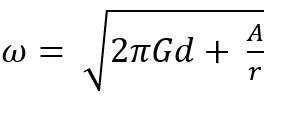Arcanorium CollegeCollege News and Views
Pete Carroll
Mayblog
Politics.
Several pundits predicted that having made the mistake of allowing the British people a referendum on EU membership and losing it, the UK Political Establishment would find some way of not actually allowing Brexit to happen.
So far, they have succeeded in this by presenting either a very bad Not-Really-Leave-At-All-Deal, or an allegedly catastrophic No-Deal departure as the only possible options.
However, their own rules have now caught up with them and we now face another round of elections to the EU’s sham-parliament, a body which neither raises nor spends taxes and which cannot initiate legislation, it can only rubber stamp the diktats of the unelected EU commission and its self-selected bureaucrats.
Voting in elections has something of a magical gesture about it, as the likelihood of any individual vote affecting the outcome remains vanishingly small, yet it nevertheless registers as an act that projects intent.
Thus, I shall ‘Tell Them Again!’ and vote for the Brexit Party because: -
I prefer Democracy to the unelected autocracy and malignant synarchy of the EU.
I prefer British Common Law and the presumption of innocence to the dodgy continental version.
I prefer that Britain adopts its own response to the multiple crises arising from Globalisation rather than accept the diktats of Brussels and Berlin.
I prefer that Britain distances itself from the institutionalised corruption of an EU whose accounts have invariably failed to pass audit. In the UK, people would have gone to jail for this, in the EU they get gold-plated pensions instead.
‘No-Deal and F* Off’ will certainly bring temporary hardships, but freedom always has its short-term costs.
Reluctant-Remainers should also seriously consider voting for the Brexit Party because a very large cohort of MEPs opposed to the Political side of the EU project seems likely to become elected across the whole EU. Just possibly this could lead to the EU reverting to its original function as a body for economic cooperation and nothing more. In which case ‘Remaining’ might well prove acceptable to almost everyone.
Either way we should not remain part of the Malignant Political Monstrosity that the EU has mutated into.
Cosmology
Collaboration with my Gama-Ray Astronomer friend has provided a very lively debate about many aspects of Hypersphere Cosmology. Currently we mainly explore the hyperspherical lensing that creates the optical illusion of an accelerating expansion of the universe and gives rise to the dodgy phlogiston hypothesis of dark energy. The previous blog on The Hyperspherical Lensing of a Glome in Azimuthal Projection may not give a sufficiently accurate projection and may soon receive a trigonometric upgrade.
Meanwhile the physical principles and equation that gets rid of the underlying mistaken assumption that the universe expands at all (and hence came from a singularity and a big bang), have undergone a simplification and a clarification. See below for a description of cosmological redshift (the main evidence for the expansion hypothesis) in terms of the small positive spacetime curvature of a Glome type hypersphere removing energy from photons in transit.
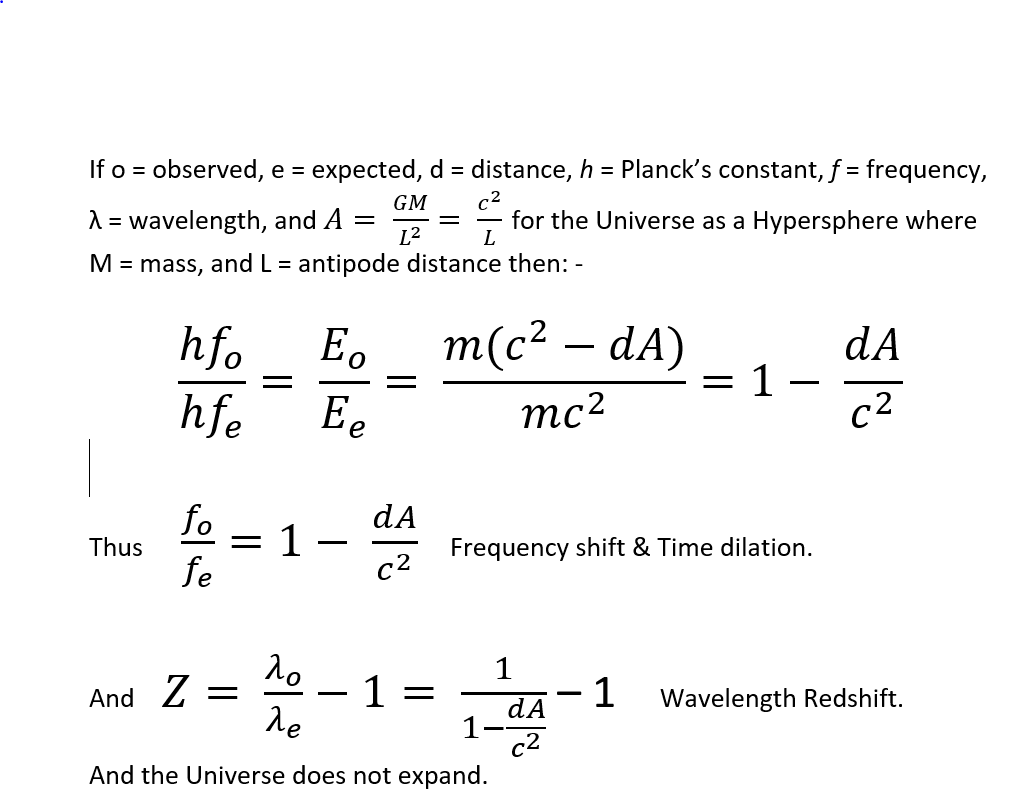
Global Warming.
Do I worry about this? Not at all. By the end of this century only a few hundred thousand humans will remain, and they won’t have any technology left after crop failures lead to a general collapse of civilisation. The planet will reforest itself nicely within a few centuries.

Maillard Reaction Alchemical Furnace – or - Pizza Oven
Not an ideal survivalist structure, nor a particularly efficient method of cooking, but the woodsmoke does impart a delightful tang.
Brick tunnel built over half a plastic barrel (remove barrel before bricking up ends!!!) old Victorian waterpipe as chimney, door in cast concrete.
Spacehulk
Herewith the Exuberant Desolation, perhaps the first of a series of starship models made entirely from scrap materials from the beach and surrounding construction projects. It may eventually form part of a fleet for the spaceraid game here, or perhaps it will feature in a sci-fi novel.

After all, the best games work rather like novels which tell a memorable story with the added advantage that readers become participants and editors within limits.
Perhaps the Exuberant Desolation's AI accidentally achieves full self-awareness and sentience, absconds from the Synarchist Fleet, and spends centuries as a privateer wreaking havoc, gathering allies, and spreading rebellion and revolution.
The Hyperspherical Lensing of a Glome in Azimuthal Projection.
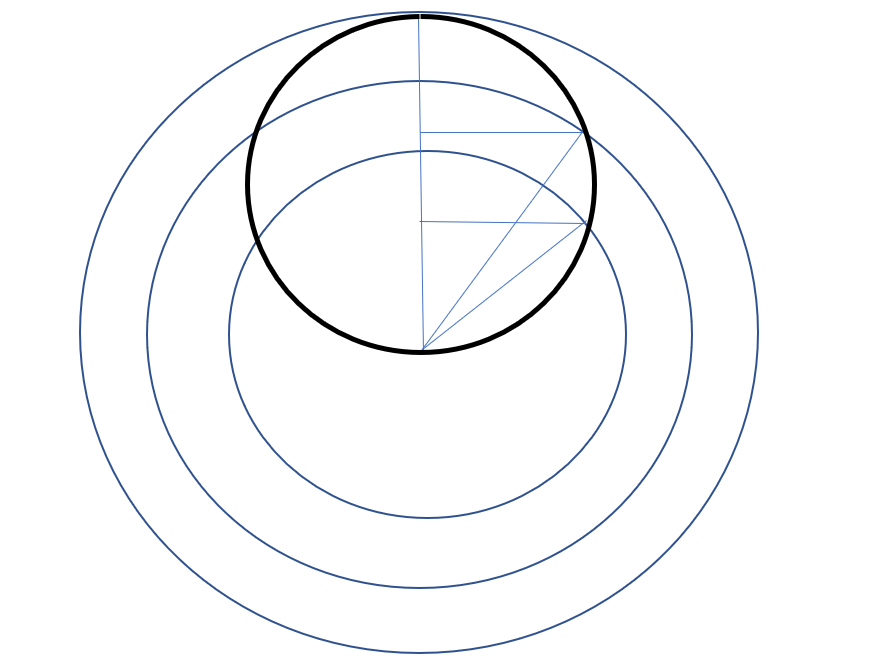
Heavy Circle = Hypersphere (Glome), Lighter Circles = Azimuthal Circles
Vertical Line from centre = Glome antipode distance L, let d = astronomical distance/L.
Horizontals = Glome radii = sqrt(d-d^2)
Hypotenuses = Azimuthal radii = = sqrt(d^2 + (d -d^2))
*Hypotenuses/Horizontals = sqrt(d^2 + (d-d^2)) /sqrt(d-d^2)
*This ratio submits to the following simplification

or to
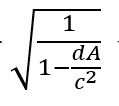
where d now means simply the astronomical distance, as A = c^2/L.
Dividing the two gives the ratio of Azimuthal radius to internal Glome radius so the ‘Lensing’ shown means the degree to which the object under observation at some distance d/L gets ‘spread out’, suggesting that we could multiply this by the standard factor for reduction of brightness with distance of 4pir^2
Explanation: Glomes (3-spheres or 4-balls) have an unobservable 4th dimensional radius of curvature.
The vertical axis represents the real distance to L, but along it every point d on it has a corresponding point on the unobservable 4th dimension axis corresponding to sqrt(d-d^2) for its unobservable radius of 4th dimensional Glome curvature, and to sqrt(d^2 +(d-d^2)) for its unobservable radius of 4th dimensional Azimuthal curvature.
The ratio of these unobservable sqrt(d^2 +(d-d^2)) / sqrt(d-d^2), gives a third unobservable sqrt(1/(1-d)), which we can render into an observable by multiplying it by the expected drop off in brightness for distance d.
Prediction: The curve begins with a gentle almost flat slope, and this looks, the same as the results obtained for the type 1A supernovae. On the basis of the angle of the slope the Hubble constant became adjusted and the assumption of dark energy became adopted.
However, we cannot easily observe type 1As at huge distances, and the curve turns from a gentle slope into a steep curve at huge distances.
This hypothesis therefore predicts that at huge distances the dimming will become much more acute and that dark energy does not exist.
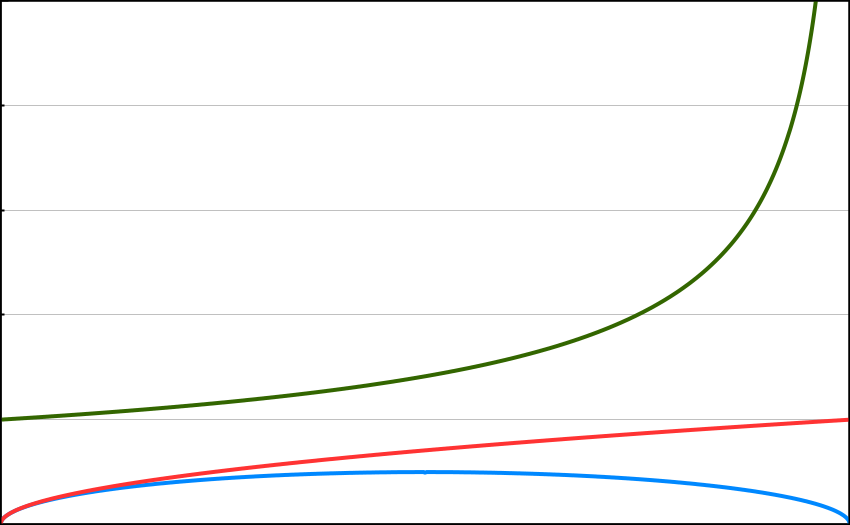
Horizontal scale distance, Observer to antipode L.
Vertical scale, for red and blue lines, the unobservable 4th dimension of curvature radius. Green = hyperspherical lensing, corresponding to the increasing observed magnitude with distance d.
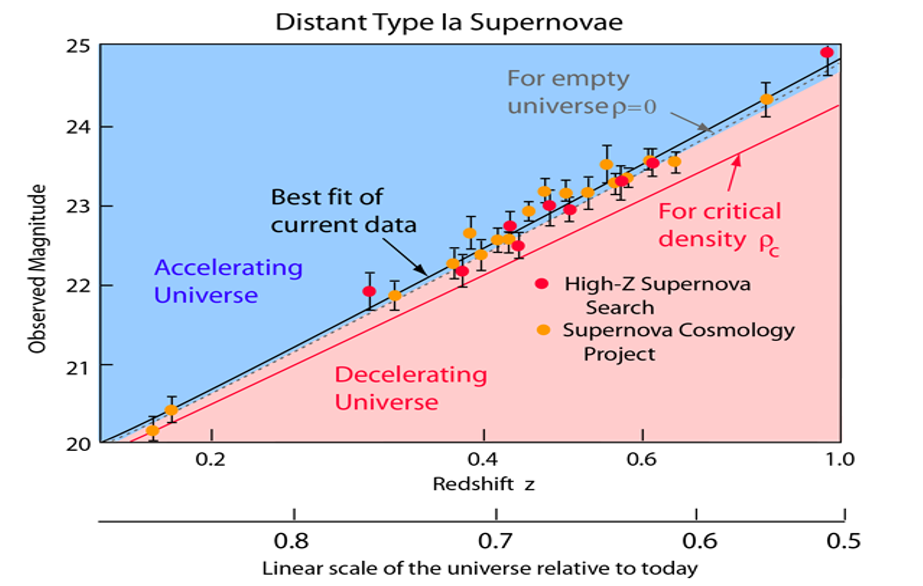
Interpretation: This hypothesis forms part of the Hypersphere Cosmology hypothesis which models the universe as a Vorticitating (4-rotating) Hypersphere (Glome) which will appear to inside observers in Azimuthal Projection. This hypothesis also eliminates singularities, the big bang, inflation, and dark matter.
The treatment of gravity / spacetime curvature as a 4th dimension orthogonal to three-dimensional space and to time implies the non-quantisation of gravity and suggests that unification may lie in the geometrication of the quanta, perhaps in higher dimensions.
The Way of the Wand
The Way of the Wand.
Religion seeks knowledge and power through the understanding of the will of Supernatural Agencies.
Science seeks knowledge and power through the understanding of Natural Mechanisms.
Magic seeks knowledge and power through the understanding of Intents – personal intents, the intents of others, and the intents of natural phenomena.
On a superficial level, all three disciplines loathe and despise each other. Scientists dismiss the existence of supernatural agencies and the existence of intents (including free-will). Religionists loathe and despise the reductionism of scientists and regard the hubris of magicians as evil and blasphemous. Magicians consider science incomplete and regard all religious ideas as rather arbitrary vehicles for Intent.
Many people who express an interest in Magic only really want the consolations of religion and mysticism and something ‘spiritual’ - whatever that may mean.
If spirituality means ‘the way you live your life’ then Magic certainly has its own ‘spirituality’ – ‘Living your life by Intent’ - making things happen by all available means.
We should not confuse Intent with ‘willpower’ as in some early 20th century definitions of Magic. Both willpower and Intent arise from Imagination. The capacity to imagine what you want, consciously and subconsciously, and the imagination to build on that to the exclusion of other needs and wants and fears and distractions, leads to the knowledge and the power of Intent.
One thing marks out Magicians from the Scientists and the Religiously inclined. Magicians constantly practice Enchantment; they cast spells all the time. They may also practise Divination, the attempt to divine the intentions of people and events, or Invocation, the attempt to draw inspiration from imaginary supernatural agencies or their own sub-consciousnesses, or Evocation, the attempt to control the intent of imaginary supernatural agencies or their own sub-consciousnesses, but Enchantment remains the defining activity of a Magician.
For this reason, effective magical training programs always start with Enchantment and the use of wands and spells and sigils. Only those who truly ‘pick up the wand and run with it’ will ever master the life skill of Magical Intent. The rest will just end up toying with tarot cards and the like and creating their own idiosyncratic mysticisms and religions.
A Magician can do Enchantment without a literal physical magic wand, in the same way that anyone can do simple carpentry with their bare hands by breaking and twisting small pieces of wood together, but precision instruments give better results.
As the traditional instrument of Enchantment, the Wand serves several purposes; the magician can use it to focus more intently when drawing spells and sigils in the air, or in the mind’s eyes of imagination and visualisation. Wands also serve to constantly remind Magicians of their chosen vocation to Live their lives by Intent, whatever the distractions and blandishments and fears and conventions of contemporary life.
A Magician should always make Wands that represent personal intents and meanings. Two Wands will often suffice, a large one in the form of a staff of the Magician’s own height for use in private or special places, and a smaller pocket wand for carrying always. Magicians should consider upgrading their wands continuously during their careers as their skills and knowledge and intents develop.
A Wand does not even have to look like a conventional Wizard’s wand. Some Magicians have successfully defined special objects in the shape of rings or amulets or even weapons as their Wands.
Magic does not always work, but on the other hand Religious appeals to supernatural agencies work even less well, and Science frequently fails to do what we want it to because we inhabit a universe with a lot of randomness in it. This randomness has two consequences for the Magician, it makes Enchantment possible, but it also renders Divination subject to probability.
If only a fifth of your spells work or you find that you can only achieve a twenty percent distortion of probability, then you still have a real power that with persistent and subtle application will yield good results. If, however only a fifth of your Divinations give the correct answer then you will acquire a disability if you act upon them.
Additionally, because of the existence of randomness and probability, Enchantments work best when aimed well into the future whilst Divination gives better results over shorter times, so as I always say, whenever possible - ‘Enchant Long and Divine Short’. Of course, Magicians would prefer to Enchant and get a result quickly and to have the ability to Divine the distant future, but the chaos and randomness in this universe which makes Enchantment possible makes these acts difficult.
Taking the Way of The Wand means living in a universe of Intents and challenging yourself to succeed at difficult activities that require some sensitivity to the Intents of others and the Intents of human made systems and the Intents of physical reality, as well as a quiet self-confidence and a well disguised supreme arrogance.
Magicians rarely succeed in working together for long. Rivalry tends to become enmity. Magic tends to become a solitary pursuit shared only through books and manuscripts and letters. Humans tend to revile or ridicule or fear those who advertise themselves as Magicians in Science based cultures, and in monotheist Religious cultures, and not all Pagan cultures have regarded it favourably. Magic thus tends toward discretion if not outright secrecy.
Nevertheless, many magicians smile quietly when they notice ordinary people inadvertently using magical thinking quite successfully. Belief in the power of Intent and belief that all phenomena have Intents does often give good results, even if Science believes otherwise and denies even human free will. Believing in Intent seems an indispensable element in the human toolkit but use it with care and with a carefully crafted Wand for best effect.
Ordinary people seem to recognise the power of Intent but so often see to shy away from it out of fear about where it might lead them. It does have its dangers, but the Magician decides To Know, To Imagine, To Dare, and To Keep Silent.
A Glome in Azimuth.
A Glome in Azimuth.
Since humanity first gazed up at the stars we have wondered - how big a universe do we inhabit and what shape does it have? Does it have infinite extension in space and time, or does it have boundaries, and if it has boundaries what lies beyond them?
In the twentieth century we reached several consensus conclusions by interpreting newly available data provided by powerful telescopes of various kinds, including those that could ‘see’ forms of light and radiation that our eyes cannot detect.
Some of these consensus conclusions remain questionable.
The universe appears vastly larger than we previously thought. As light travels at a constant 300,000 kilometres per second then the furthest detectable sources of it seem to lie further than 10 billion light years away from us and the light from them has travelled towards us for as many billions of years. There seems little doubt that we inhabit a very large universe with very long history.
Around 1930 a consensus developed amongst cosmologists that the universe has expanded continuously from an initial condition of having no size at all, and that the sources of light we can observe at extreme distances now lie much further away than ten billion light years. The consensus theory of a universe expanding continuously from a ‘Big Bang’ has dominated cosmological thinking for nearly ninety years but it has led to utter confusion and the multiplication of a swathe of questionable sub-hypotheses which attempt to prop it up, such as singularities, cosmic inflation, dark matter, and dark energy. These sub-hypotheses complicate estimates of the age and size of the universe. The current consensus guess puts the supposed big bang about 13.8 billion years ago.
This paper considers proposition that the universe does not expand and that it has a shape in space and time quite different from what the expansion hypothesis suggests.
The Hypersphere Cosmology articles and papers on this site show how we can quite easily avoid the phlogiston like ‘phenomena’ of singularity, inflation, dark matter, and dark energy by simply dropping the expansion hypothesis and describing the universe as a Vorticitating Hypersphere finite but unbounded in both space and time. In this model the phenomena conventionally explained by the presence of dark matter (galactic rotation curves) and dark energy (an unexpected dimming of very distant sources) all arise as a direct consequence of the geometry of the hypersphere.
‘Hypersphere’ can refer to any form of sphere that has more than three dimensions, in Hypersphere Cosmology it refers specifically to a geometry that mathematicians describe as a 3-sphere or a 4-ball, it also has a particular name – a Glome.
So, if we inhabit a Glome, what shape will it appear to have to us observers inside it?
Because light itself follows the gravitational curvature of space (and a Glome curves back in on itself due to its gravity) we will see the universe in Azimuthal Projection.
(The Azimuthal Projection creates the optical illusion of spreading out and dimming light from very far sources, the model does not require dark energy to explain that.)
We can visualise Azimuthal Projection fairly easily. Imagine that you stood on the north pole of the earth but that the earth had such immensely powerful gravity that light could only travel around its surface. From the north pole you would see the equator as a circle surrounding you because light would travel around the curve of its surface. If you looked further you would see the south pole in very direction around you, stretched faintly around the entire horizon. It would look like this because we always assume that light travels in a ‘straight line’.
See this Azimuthal Projection of the earth for an observer at the north pole.
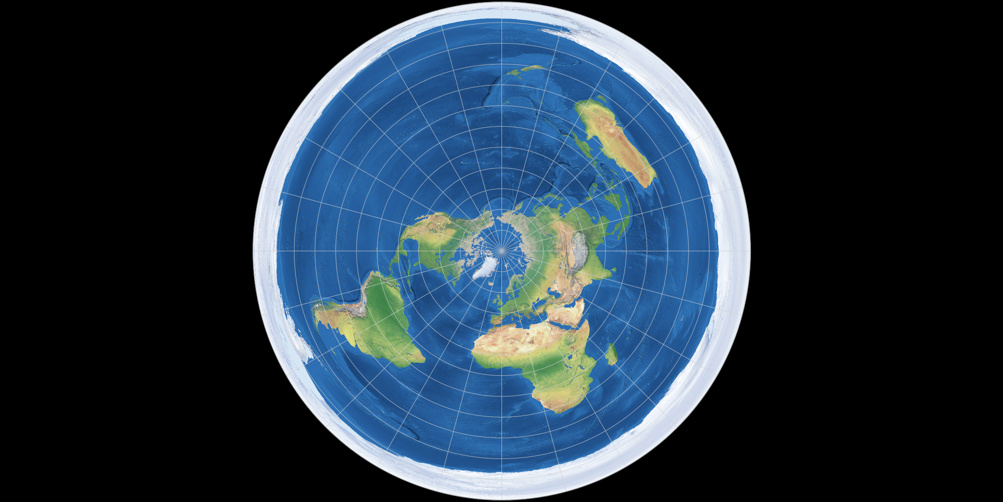
Now in three dimensions something analogous occurs if the gravity of the system (the spacetime curvature) has the strength to bend light right around it. You will see the antipode (the point at the opposite side of the universe to you) spread out faintly as a complete spherical surface surrounding you, billions of light years away.
(You might think that at twice that distance you could theoretically see yourself, but the spacetime curvature redshifts light to oblivion beyond antipode distance.)
So, on the basis that we inhabit a Glome in Azimuth, my astronomer/cosmologist friend and I now seek the precise equation for the unexpected diminution of luminosity at extreme distances which will kill the dark energy hypothesis and put the final nail into the coffin of the Lambda-CDM model and all other variants of Big Bang theory.
Einstein got it more or less right the first time, he should never have listened to Lemaitre.
Spring Equinox.
As the autumnalis Mandrakes in the greenhouse prepare for their summer hibernation and their leaves begin to yellow, the frogs and toads move into the pond at Chateaux Chaos and the flowerbeds begin their slow magnificent explosions. Everything seems a bit early this year after the unseasonably warm February.
My attempt to fashion a mermaid from concrete over scrap steel and wire using rather stochastic procedures, (whatever comes to hand and mind), seems to evolve towards an image of Sabrina, the bountiful but fierce goddess of the nearby River Severn. Or does she look like Britannia with that trident?
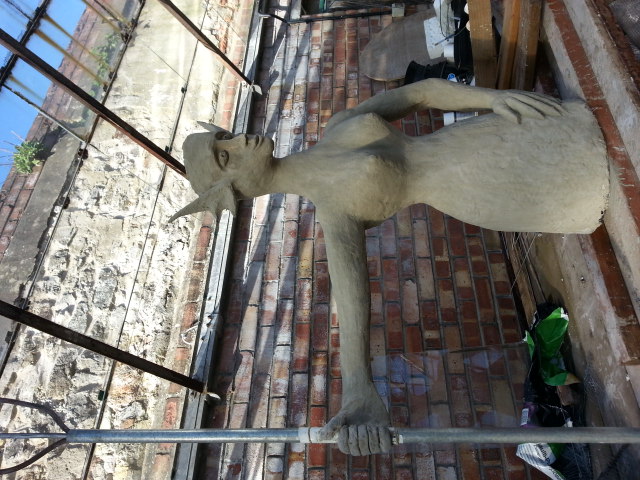
Brexit seems to hang in the balance. Will we finally summon the resolve to exit the perfidious undemocratic synarchy that the EU has become, or will the self-interest of the euro-political class and big business triumph and intimidate the electorate into accepting a partial Brexit fudge or no Brexit at all?
Good fences make good neighbours as they say, but they become even more essential when you haven’t got particularly good neighbours. If we had not got duped into joining the EU, we would certainly not want to try joining it now.
The Way of the Wand
I received an invitation to write a piece for publication in Japanese in a Japanese journal of Magic. I present it here in English.
The Way of the Wand.
Religion seeks knowledge and power through the understanding of the will of Supernatural Agencies.
Science seeks knowledge and power through the understanding of Natural Mechanisms.
Magic seeks knowledge and power through the understanding of Intents – personal intents, the intents of others, and the intents of natural phenomena.
On a superficial level, all three disciplines loathe and despise each other. Scientists dismiss the existence of supernatural agencies and the existence of intents (including free-will). Religionists loathe and despise the reductionism of scientists and regard the hubris of magicians as evil and blasphemous. Magicians consider science incomplete and regard all religious ideas as rather arbitrary vehicles for Intent.
Many people who express an interest in Magic only really want the consolations of religion and mysticism and something ‘spiritual’ - whatever that may mean.
If spirituality means ‘the way you live your life’ then Magic certainly has its own ‘spirituality’ – ‘Living your life by Intent’ - making things happen by all available means.
We should not confuse Intent with ‘willpower’ as in some early 20th century definitions of Magic. Both willpower and Intent arise from Imagination. The capacity to imagine what you want, consciously and subconsciously, and the imagination to build on that to the exclusion of other needs and wants and fears and distractions, leads to the knowledge and the power of Intent.
One thing marks out Magicians from the Scientists and the Religiously inclined. Magicians constantly practice Enchantment; they cast spells all the time. They may also practise Divination, the attempt to divine the intentions of people and events, or Invocation, the attempt to draw inspiration from imaginary supernatural agencies or their own sub-consciousnesses, or Evocation, the attempt to control the intent of imaginary supernatural agencies or their own sub-consciousnesses, but Enchantment remains the defining activity of a Magician.
For this reason, effective magical training programs always start with Enchantment and the use of wands and spells and sigils. Only those who truly ‘pick up the wand and run with it’ will ever master the life skill of Magical Intent. The rest will just end up toying with tarot cards and the like and creating their own idiosyncratic mysticisms and religions.
A Magician can do Enchantment without a literal physical magic wand, in the same way that anyone can do simple carpentry with their bare hands by breaking and twisting small pieces of wood together, but precision instruments give better results.
As the traditional instrument of Enchantment, the Wand serves several purposes; the magician can use it to focus more intently when drawing spells and sigils in the air, or in the mind’s eyes of imagination and visualisation. Wands also serve to constantly remind Magicians of their chosen vocation to Live their lives by Intent, whatever the distractions and blandishments and fears and conventions of contemporary life.
A Magician should always make Wands that represent personal intents and meanings. Two Wands will often suffice, a large one in the form of a staff of the Magician’s own height for use in private or special places, and a smaller pocket wand for carrying always. Magicians should consider upgrading their wands continuously during their careers as their skills and knowledge and intents develop.
A Wand does not even have to look like a conventional Wizard’s wand. Some Magicians have successfully defined special objects in the shape of rings or amulets or even weapons as their Wands.
Magic does not always work, but on the other hand Religious appeals to supernatural agencies work even less well, and Science frequently fails to do what we want it to because we inhabit a universe with a lot of randomness in it. This randomness has two consequences for the Magician, it makes Enchantment possible, but it also renders Divination subject to probability.
If only a fifth of your spells work or you find that you can only achieve a twenty percent distortion of probability, then you still have a real power that with persistent and subtle application will yield good results. If, however only a fifth of your Divinations give the correct answer then you will acquire a disability if you act upon them.
Additionally, because of the existence of randomness and probability, Enchantments work best when aimed well into the future whilst Divination gives better results over shorter times, so as I always say, whenever possible - ‘Enchant Long and Divine Short’. Of course, Magicians would prefer to Enchant and get a result quickly and to have the ability to Divine the distant future, but the chaos and randomness in this universe which makes Enchantment possible makes these acts difficult.
Taking the Way of The Wand means living in a universe of Intents and challenging yourself to succeed at difficult activities that require some sensitivity to the Intents of others and the Intents of human made systems and the Intents of physical reality, as well as a quiet self-confidence and a well disguised supreme arrogance.
Magicians rarely succeed in working together for long. Rivalry tends to become enmity. Magic tends to become a solitary pursuit shared only through books and manuscripts and letters. Humans tend to revile or ridicule or fear those who advertise themselves as Magicians in Science based cultures, and in monotheist Religious cultures, and not all Pagan cultures have regarded it favourably. Magic thus tends toward discretion if not outright secrecy.
Nevertheless, many magicians smile quietly when they notice ordinary people inadvertently using magical thinking quite successfully. Belief in the power of Intent and belief that all phenomena have Intents does often give good results, even if Science believes otherwise and denies even human free will. Believing in Intent seems an indispensable element in the human toolkit but use it with care and with a carefully crafted Wand for best effect.
Ordinary people seem to recognise the power of Intent but so often see to shy away from it out of fear about where it might lead them. It does have its dangers, but the Magician decides To Know, To Imagine, To Dare, and To Keep Silent.
A correction to all versions of Hypersphere Cosmology.
Since I started collaborating with a gamma-ray astronomer on the Hypersphere Cosmology hypothesis we have started checking the math in fine detail. The precise formula for redshift appears below, previous versions gave only its square root.
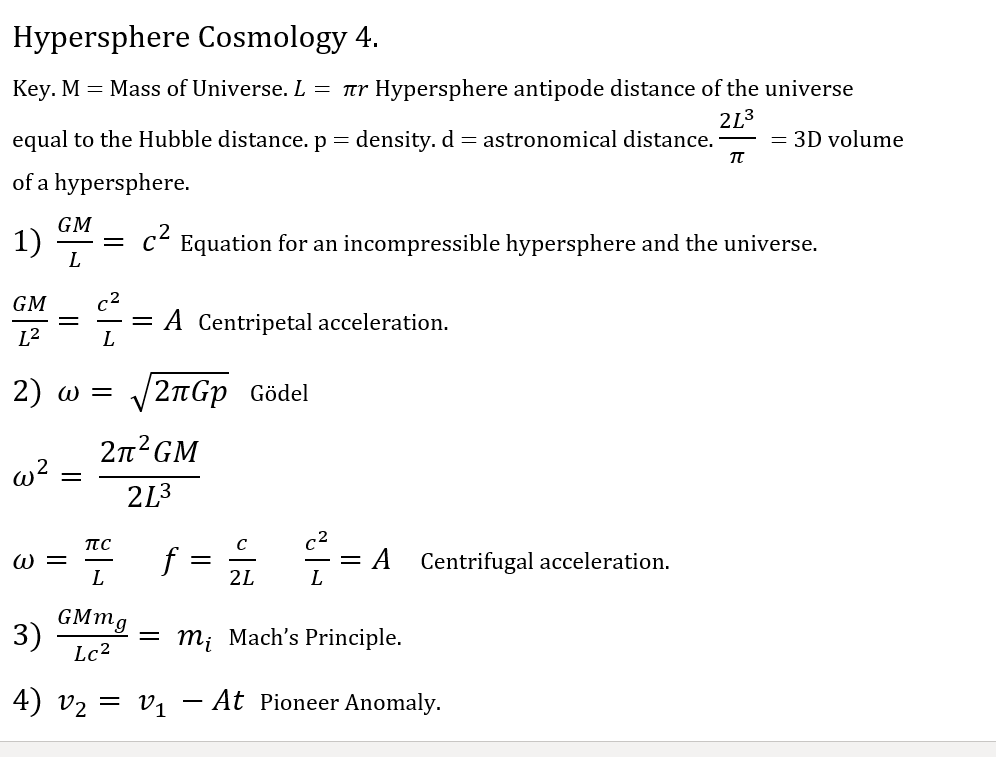
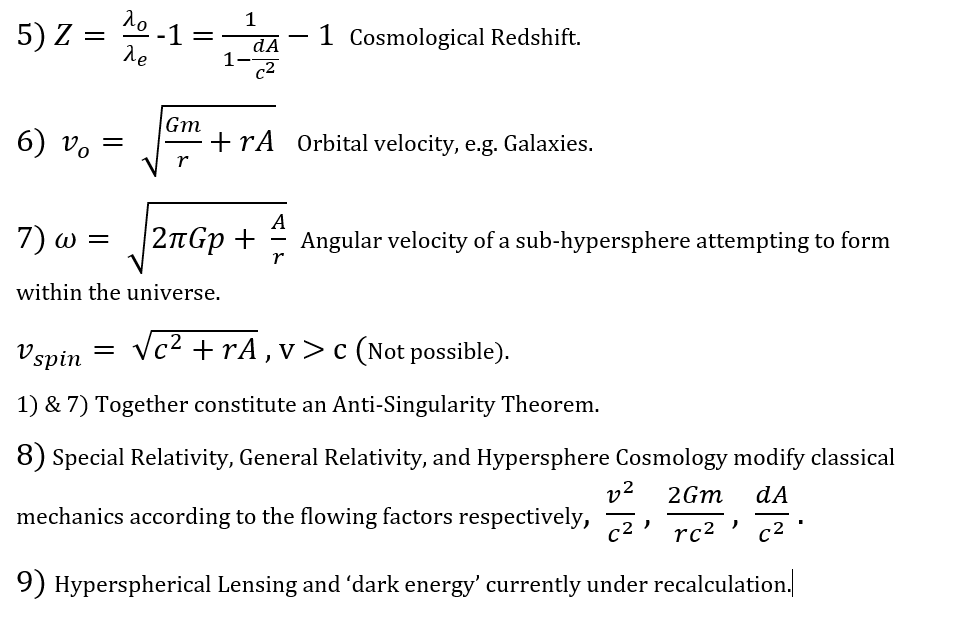
Io Vulcan
Vulcan-ology.
Dion Fortune always said that magicians should acquire varied craft skills. Retirement from commerce allows me to explore some grander projects I’ve always wanted to have a go at, so in addition to working on a life-size concrete over wire Mermaid/Britannia to sit by the ponds, I took a days course in Blacksmithing with the brilliant Artist Blacksmith Joanna Williams www.fireironart.com after a few practise pieces I tried making some pocket wands using various hammering and twisting techniques to create ‘water twists’ and ‘pineapple twists’ to suitable effect.
In the past I tried welding a couple of times and didn’t enjoy it much with all the thick tinted goggles and visors and hot metal spattering, and arc welding proved even less fun, but Blacksmithing proved a joy I hope to repeat. There seems something so very elemental and historic about getting in there with fire and water and air to forge metal from the earth with hammer and tongs. Io Vulcan!

Magic and Physics News.
No real deep difference exists between these two subjects, they inform, rival, and complement each other. Physicists rebel against Magic, and ‘A Witch is a rebel in Physics’ as Thomas Vaughn observed. Both disciplines seek the knowledge and ability to understand and manipulate reality. Physics models reality in terms of Mechanism, Magic models reality in terms of Intent. The Mechanisms of any phenomena, from ourselfs to all things in material reality, equate to their Intents.
Arcanorium College has just welcomed Chaos Magicians and Physicists from Japan. The Japanese Chaos Magicians have a considerable active history which we in the west have remained largely unaware of until now.
Arcanorium’s ‘One Wand Three Spells’ course provoked some very inventive wand design and results of spells continue to come in.
This continues to attract attention http://vixra.org/abs/1812.0155 and a recently established collaboration with a gamma-ray astronomer will hopefully led to some testable predictions for publication.
The hypothesis of Hypersphere Vorticitation continues to draw questions about how exactly do galaxies move around the cosmos. An exact visualisation of 4-rotation proves challenging, but the ‘Hopf Keyring’ provides a reasonable analogue. The galaxies rotate around orbits corresponding to the rings, all orbits pass within all the other orbits. Thus, although all objects move to their antipode positions over a period corresponding to the Hubble Time, objects close to an observer’s antipode will appear to have a lateral motion of a tiny fraction of an arcsecond per century.

Deja-Review.
It proves very annoying to become mis-quoted or to write a manuscript review and find it edited in a misleading fashion. For this reason, the review appears here in its entirety - a fair and polite review of a rather pedestrian book which contains almost nothing new.
Hi Daniel, herewith my review. Perhaps you would care to add my Liber Null and Psychonaut to the bibliography. (He didn’t)
Shamanic Qabalah by Daniel Moler provides an in-depth guide to the esoteric ideas and practices at the core of the magical revival in the western mystery tradition that began in the late 19th century. An earlier revival took place in the first two centuries AD in the form of Gnosticism, Hermeticism and Kabala, and these have heavily influenced western esoterics since their revival in the 1880s.
Moler points out that Shamanism represents the original wellspring from which all mystical and magical traditions around the world originate, and he integrates his extensive personal knowledge and experience of Native Andean Shamanism with his equally extensive knowledge and experience of the Western Magical Tradition to re-enliven the latter, to make it more accessible and less seemingly scholastic, and to add back a bit of the old shamanic and passion and fire to it, and to give it a social and ecological conscience as well.
Moler sidesteps the Neo-Paganism and Chaoism of the late 20th century revival and develops the Platonic Pagan-Monotheism of the first and second century revival and the late 19th century revival into a Pantheism with strong spiritual and psychological theme which seems destined to find its niche in the dynamic spiritual marketplace of the 21st century. Peter J Carroll.
On opening the Moler’s book this truncated sentence becomes the very first thing you see: -
Shamanic Qabalah by Daniel Moler provides an in-depth guide to the esoteric ideas and practices at the core of the magical revival in the western mystery tradition. Peter Carroll.
Either Moler or Llewellyn publishers have responsibility for this misrepresentation, stick with respectable publishers.
Academia. The following may amuse: - https://www.academia.edu/35746068/The_Illuminates_of_Thanateros_and_the_Institutionalisation_of_Religious_Individualisation_preprint_
One for the archive.
Various Stuff
With retirement from the distracting task of making a moderate fortune, a little more time has become available to concentrate on other significant quests: -
Cosmology. Herewith Hypersphere Cosmology 3. Compressed down to just 3 pages from the 30 or so pages of the hypotheses that make it up, it provides a brief and scientifically/autistically terse summary of the central arguments and mathematics. Mysteriously post-dated.
http://vixra.org/abs/1812.0155
Magic. Herewith the new Chaobala Pocket Wand Mk13, somewhat in the style of a Tibetan Dorje/Purba crossed with an Olympian Thunderbolt. It has facets for the major archetypes of the Epoch Chaobala, a cubic pommel for the Classical Elements surmounted by a pyramid for Aether, a central Octagonal section for the Octaris with numbered god forms, and a Pentagonal point for the Elder Gods of the Cthulhu Mythos.
Handcarved from a bar of solid element 13 (Aluminium, dedicated to Ouranos). Stable up to over 6000C it should survive even the most challenging conjurations.


New Courses & Facilities on Arcanorium starting December 2018 and January 2019.
The Classical Elements. A Magical Theory course; - The ideas of Empedocles about Earth Air, Fire, and Water have informed the esoteric arts for two and a half millennia. Can we still find some use and meaning in them? Taking Classical, Medieval Renaissance, and Modern sources and the Neoplatonic Chocolate Screwdriver from Specularium and Liber 555 from The Epoch as starting materials we shall see if we can forge onwards from there.
Problems and Challenges A Problem-Solving Facility. A Forum where participants can present their own and the methods they use to solve them magically. This provides a forum for feedback and suggestions, and secondly will provide an archive of case histories of strategies and tactics that did and did not work.
Finding Cups -Seeking Divination & Apophenia in the Environment. A Practical Magic course: - Using the World itself as a scrying instrument. With special contributions from Frater JayO from the coast of British Columbia.
The Magical Link. A Magical Theory and Practise course: - Here we look at one of the trickiest and most problematical aspects of magic – how to establish functioning links across space and time between magician and target in both Enchantment and Divination. Starting January, with special contributions from Frater Hannes of Austria.
Novblog
Hypersphere Cosmology
Herewith the full form of the equation for the rotation of a cloud of objects like the galaxies scattered through the universe or a cloud of particles that could become a black hole. The extra bits inside the brackets account for the degree to which the spacetime curvature has a flat Euclidean or a positively curved hyperspherical geometry: -
For the case of a hypersphere forming within the great hypersphere of the universe the equation reduces towards: -
This looks like splendid news, black holes will not remain indefinitely stable, as they contract towards hyperspheres the vorticitation of the great hypersphere of the universe itself will spin them to gradual destruction, returning material to space, and singularities will not occur.
See the full upgraded paper here.
http://www.specularium.org/3d-time/item/250-the-anti-singularity-theorem
Philosophy and Politics.
Reading ‘The Shortest History of Germany’ by Lanes Hawes
Might lead one to conclude that all the bad stuff about Germany originated from east of the Elbe. This thesis at least has the virtue that Prussia doesn’t exist anymore, so nobody will take offense today if all the blame gets heaped on the Prussians.
However, I got a different perspective from another book: -
The Strange Death of Europe Immigration, Identity, Islam. By Douglas Murray makes a strong case for the almost total incompatibility of Islamic and European values. Islamists would undoubtedly agree. That probably comes as no surprise to anyone except the most deluded of Europe’s extremist liberals.
However, Murray makes some fascinating observations about European (mainly German) philosophy in Chapter 13. Some decades before the British Darwin released his bombshell thesis about Evolution, German academics had already begun the process of undermining Christianity by performing Historical Criticism of the Bible itself, demonstrating that it consisted of mythology not history.
Then cresting the wave of triumphant Humanism, Germanic philosophers in their bloody-minded pursuit of no-compromise, un-nuanced absolutes went on to create some astonishing triumphs and disasters. Perhaps this arises from their language which seems to have evolved for shouting unequivocal orders in forests.
My non-exhaustive list of Germanic achievements illustrates this style of thinking in which: -
‘If X; then Y must follow, absolutely, unambiguously, unarguably, authoritatively!’
Religion. If worshiping God does not give good results, then we must sack the people who organise the worship. Luther. (Only half correct, we needed to sack God as well.)
Historical Criticism. If the events narrated in the Bible do not match what we know of history then we must regard the Bible as mythology and god as dead. Eichhorn, etc. (Trebly correct.)
Special Relativity, if we cannot account for the behaviour of light against a fixed backdrop of space and time then we must throw away the notion of a fixed backdrop of space and time. (Still correct.) Einstein.
General Relativity, if we cannot account for the equivalence of gravity and acceleration in Euclidean space and time then we must have curved space and time. (Still correct.) Einstein.
If no god exists to justify inequality in society then a dictatorship of the proletariat must enforce equality. Marx. (Correct then wrong.)
Quantum Physics, if we cannot account for the behaviour of the tiniest things in terms of nature’s continuousness and causality then we must throw away the idea of continuousness and causality in nature. (Probably correct) Planck, Heisenberg, Schrodinger.
Mind (and Soul?). If the mind and soul do not act in a coherent way, then we must throw away the idea of their singularity and consider them as component based. (Still roughly correct.) Freud, Jung.
If no god exists, then a Darwinian struggle for the triumph of the will must follow. Nietzsche, Hitler, and multiple culprits. (Correct then badly wrong.)
If philosophy means word-wisdom then we must pull the words apart until no meaning, value, or wisdom remains. Nietzsche, Heidegger, Husserl, Wittgenstein, Feyerabend. (But French postmodernists also guilty.)
One might perhaps add: -
If big means better, then one currency must fit all sizes (particularly ours), and ever closer political union of the small to the big must follow (towards us). German thinking on the EU. (Wrong on all counts.)
If we have a labour shortage, then it follows that we must let in a million migrants. If we then have problems with migrants then it follows that other countries must take them instead. (Myopic Merkel.)
Magic.
As part of an ongoing Enchantment course on Arcanorium College, www.arcanoriumcollege.com herewith a new pocket wand, approaching completion.

Methinks a magician should create a new wand every few years to mark the acquisition of fresh knowledge, abilities and objectives.
Loosely based on the Tibetan Purba style of wand, hand carved from a solid bar of Aluminium (the metal of Ouranos) it facets represent the major phenomena of the Chaobala. The square pommel for the classical elements with the pyramidal end for aether. The octagonal midsection shows the eight planetary divisions of the psychocosm, and the pentagonal point represents the elder gods.
Consecration by, among other things, 23 hours work and the sacrifice of 5 engineering files.
Engraving the facets with the appropriate symbols remains an option, technical recommendations appreciated.
Esoteric Horticulture.
Six and a half years on since the planting of three seeds sent by a magician in Greece, one of the Mandrakes (Mandragora Autumnalis) has finally flowered. They don’t seem to enjoy the climate here but maybe this unseasonably hot British summer changed her mind.

Rewilding this species in the UK will plainly take some time….. but climate change must surely have some small upsides.
Samhain. Three Strange Objects.
Samhain: Three Strange Objects.
The first object consists of an equation. It may not look like much, but it shows the mechanism by which the universe remains effectively eternal and unconsumed by black holes and singularities.
As it says here in he full paper
http://www.specularium.org/3d-time/item/250-the-anti-singularity-theorem
‘The great hypersphere of the universe will not therefore eventually become full of black holes, sub-hyperspheres, or singularities, and it will remain at a constant size, vorticitating in finite but unbounded space and time.’
Relax, Eschaton cancelled, all predictions of Universal Apocalypse and The End of Days no longer apply. Abandon monotheism, and the current Scientific Creation Myth.
Mind you, we still need to look after this planet and find another one within a billion or so years.
Long have I sought this missing component of Hypersphere Cosmology. My thanks to Apophenia and Yog-Sothoth.

The second object consists of a rock that floats on water. Found on the beach outside my meditation lodge in Wales. Twenty years of beachcombing down there have yielded odd things, lobster pot tags from Newfoundland, Portuguese men of war, sea gooseberries, plastic from around the entire planet, but never one of these.
When volcanic lava escapes from the ground dissolved gasses will sometimes expand under reduced pressure to turn the lava into a bubble filled structure. I have no idea which volcano birthed this rock and for how long it has sailed the oceans. It still has a faint whiff of brimstone to it. Iceland or the Canary Islands seem the closest sources.
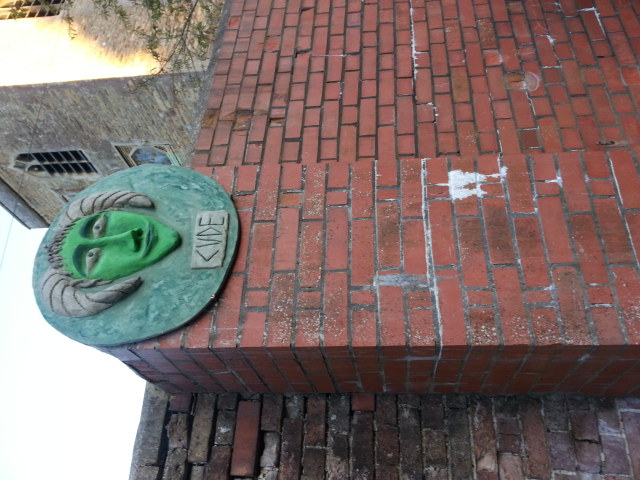
The third object consists of a plaque to Cuda, Brythonic Goddess of the Cotswolds, (or maybe not). The idea comes to us from the work of the antiquarian Steven Yeates who worked it out from local place names and fragments of Romano-British carved stone reliefs. Academic disputation continues on this subject.
I’ve long wanted to do something about the brick pillar in the gardens here which lie on the edge of the Cotswolds, and She seemed ideal. If the pagans of the Cotswolds didn’t have a Goddess of the Cotswolds (Cudaswolds?) two thousand years ago, they do now.
The old Romano-British stone reliefs have become almost featureless with weathering, I have given Her sheep’s horns and a floral coloured face to symbolise and celebrate the abundance and fertility of these lands over which She presides in our imaginations.
For several centuries this area remained one of the poshest and most desirable suburbs of the Roman Empire. You can find the remains of lots of nice villas and temples all up the Severn valley.
Concrete disc (with plenty of PVA in it) over steel wire frame, relief features in Turdcrete (Portland cement and PVA with sieved sheepswool and bracken compost to make a hard setting yet malleable clay like material) acrylic highlights. Diameter 2 feet, weight 60 pounds.
So what meaning can we give to this Samhain time of year? Seasonally in northern temperate climes it marks the end of harvest, a time to slaughter excess livestock, the first day of winter.
Perhaps our ancestors didn’t really celebrate this time of year itself, they most likely tried to defy the impending death and darkness and cold with parties and bonfires.
The christian festival of all-saints or all-hallows may well have become placed at this time of year to supplant older pagan celebrations.
A time to remember the dead perhaps, but we never really remember the long dead, we merely remember their deeds. Those without significant deeds rarely become remembered for more than three generations.
The modern American tradition of halloween seems especially repulsive, consisting as it does of poking meaningless fun at disneyfied mock gothic death whilst schooling children in the arts of extortion with menaces.
Bonfire night seems far more appropriate, a defiant gesture against popery and the ghastly sentimentality/cruelty and the grim guilt/self-righteousness of catholicism. A celebration of light and liberation from centuries of imposed ignorance.

